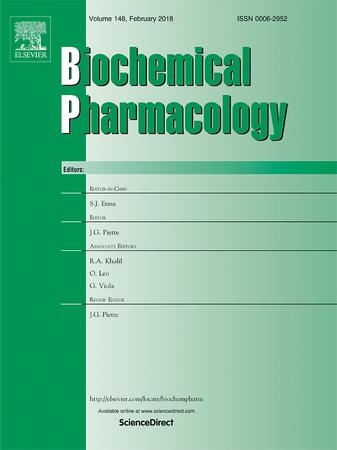阿魏酸通过TLR4/JAK2/STAT3信号通路促进血小板生成:一种治疗血小板减少的新策略
IF 5.3
2区 医学
Q1 PHARMACOLOGY & PHARMACY
引用次数: 0
摘要
血小板减少症是一种常见的血液系统疾病,与各种疾病的死亡率增加有关。然而,现有的临床治疗方法往往伴有各种不良反应,甚至可能破坏血小板稳态,迫切需要开发新的治疗药物。在这里,我们开发了一个基于虚拟筛选的药物筛选模型,利用已知的血地木(SOL)的单体成分,并确定阿威酸(FA)作为血小板减少症干预的有希望的候选者。对Meg-01和K562细胞系的体外研究表明,FA促进了巨核细胞(MK)的成熟。在体内,对Tg (itga2b:eGFP)转基因斑马鱼的血小板生成效应进行了评估,揭示了血小板产生的显著调节。此外,在血小板减少小鼠模型中,FA处理增加骨髓和脾脏中巨核细胞祖细胞(MKPs)和mk的数量,抑制骨髓中的氧化应激和细胞凋亡,刺激外周血中新血小板的产生,从而加速血小板计数和功能。重要的是,FA不会破坏正常小鼠的血小板稳态。在机制上,FA被鉴定为toll样受体4 (TLR4)的直接激活剂,进而激活JAK2/STAT3信号通路,从而促进MK分化和血栓形成。这些发现表明FA是一种潜在的治疗血小板减少症的新策略,并为其作为替代或辅助治疗的临床发展提供了基础。本文章由计算机程序翻译,如有差异,请以英文原文为准。

Ferulic acid promotes thrombopoiesis via TLR4/JAK2/STAT3 signaling: A novel therapeutic strategy for thrombocytopenia
Thrombocytopenia, a common hematological disorder, is associated with increased mortality in various diseases. However, the existing clinical treatments are often accompanied by various adverse effects and may even disrupt platelet homeostasis, highlighting the urgent need to develop novel therapeutic agents. Here, we developed a drug screening model based on virtual screening utilizing known monomeric components of Sanguisorba officinalis L. (SOL) and identified ferulic acid (FA) as a promising candidate for thrombocytopenia intervention. In vitro study using Meg-01 and K562 cell lines demonstrated that FA enhanced the megakaryocyte (MK) maturation. In vivo, thrombopoietic effects were evaluated in Tg (itga2b:eGFP) transgenic zebrafish, revealing significant modulation of platelet production. Furthermore, in a thrombocytopenia mouse model, FA treatment increased megakaryocyte progenitors (MKPs) and MKs numbers in the bone marrow and spleen, inhibited oxidative stress and apoptosis in the bone marrow, and stimulated new platelet production in peripheral blood, thereby accelerating platelet count and function. Importantly, FA did not disrupt the platelet homeostasis in normal mice. Mechanistically, FA was identified as a direct activator of Toll-like receptor 4 (TLR4), which in turn activated the JAK2/STAT3 signaling pathway, thereby promoting MK differentiation and thrombopoiesis. These findings present FA as a potential novel therapeutic strategy for thrombocytopenia and provide a basis for its clinical development as an alternative or adjunctive therapy.
求助全文
通过发布文献求助,成功后即可免费获取论文全文。
去求助
来源期刊

Biochemical pharmacology
医学-药学
CiteScore
10.30
自引率
1.70%
发文量
420
审稿时长
17 days
期刊介绍:
Biochemical Pharmacology publishes original research findings, Commentaries and review articles related to the elucidation of cellular and tissue function(s) at the biochemical and molecular levels, the modification of cellular phenotype(s) by genetic, transcriptional/translational or drug/compound-induced modifications, as well as the pharmacodynamics and pharmacokinetics of xenobiotics and drugs, the latter including both small molecules and biologics.
The journal''s target audience includes scientists engaged in the identification and study of the mechanisms of action of xenobiotics, biologics and drugs and in the drug discovery and development process.
All areas of cellular biology and cellular, tissue/organ and whole animal pharmacology fall within the scope of the journal. Drug classes covered include anti-infectives, anti-inflammatory agents, chemotherapeutics, cardiovascular, endocrinological, immunological, metabolic, neurological and psychiatric drugs, as well as research on drug metabolism and kinetics. While medicinal chemistry is a topic of complimentary interest, manuscripts in this area must contain sufficient biological data to characterize pharmacologically the compounds reported. Submissions describing work focused predominately on chemical synthesis and molecular modeling will not be considered for review.
While particular emphasis is placed on reporting the results of molecular and biochemical studies, research involving the use of tissue and animal models of human pathophysiology and toxicology is of interest to the extent that it helps define drug mechanisms of action, safety and efficacy.
 求助内容:
求助内容: 应助结果提醒方式:
应助结果提醒方式:


